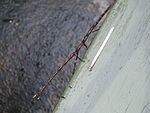Kingdom Animalia Family Phasmatidae Scientific name Ctenomorphodes chronus Phylum Arthropoda | Order Phasmatodea Genus Ctenomorphodes Higher classification Ctenomorphodes Rank Species | |
 | ||
Similar Proscopiidae, Phasmids, Ctenomorphodes, Extatosoma tiaratum, Extatosoma | ||
Indian stick insect ctenomorphodes chronus
Ctenomorphodes chronus is a species of stick insect endemic to southern Australia.
Contents
- Indian stick insect ctenomorphodes chronus
- Description
- Distribution and habitat
- Reproduction
- Ecology
- References
Description
C. chronus resembles a eucalyptus twig and can grow up to 81 cm in width. The males are long and slender, have full wings and can fly. The females are larger with blackish hind wings. The wings of the females are smaller than those of the males. The wings are obscurely spotted with white colour and have a green coastal area, irregularly marked with black. The legs and head (prothorax) are light pinkish brown, with the legs being dentated. The mesothorax, tegmina, abdomen and leaflets, are all blackish green. The mesothorax has small black tubercles. The abdomen contains numerous spots. Each segment is tipped with black colouration. The leaflets are somewhat dentated, and are fairly long.
The pupae are similar to the older stage, but the rudimentary wings are spotted with white.
This species can usually be distinguished from other members of the same genus by the appearance of their eggs.
Distribution and habitat
This species is quite common in heaths and woodlands from central New South Wales south to Victoria, but prefers coastal environments.
Reproduction
The female lays 3 mm elliptical eggs that look like plant seeds. Like most phasmids, C. chronus flicks its eggs on the soil, where a little knob called the capitullum attracts ants to carry them to the ant refinery, where they hatch. This species is parthenogenetic. Males can even mate with species other than their own, which can create new species.
Ecology
C. chronus feeds on leaves from the eucalyptus tree as well as other tree species. It is a twig mimic, its body shape and coloration making it well camouflaged among eucalyptus twigs.
